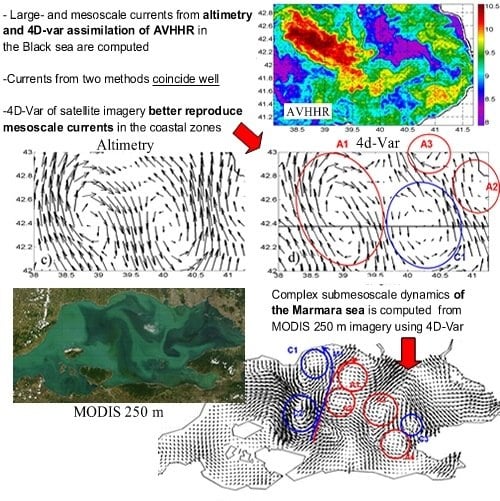Reconstructing Large- and Mesoscale Dynamics in the Black Sea Region from Satellite Imagery and Altimetry Data—A Comparison of Two Methods
Abstract
1. Introduction
2. Materials and Methods
2.1. Satellite Altimetry
2.2. Surface Currents from Variational Assimilation of Satellite Image Sequences
- Choose initial T0, u0, v0 values. Initial fields for the first iteration are: .
- Integrate Equation (2) and obtain the corresponding J value.
- Solve adjoint system (4) with the starting conditions to calculate the gradient of J.
- Obtain new T0, u0 and v0 as a local minimum of J via quasi-Newton descent.
- Go to step 2 if the required accuracy is not achieved; otherwise, u0 and v0 are final resulting velocity field components.
- Remove cloud-covered regions in conjunction with interactive processing by the operator. Clouds in the AVHHR imagery are detected using a method based on [74], which uses a series of threshold tests in individual AVHRR channels.
- Remove small-scale noise using normalized box filter with 3 × 3 kernel.
- Remove large-scale noise using a high-frequency moving average with a large window size (about 50 × 50) This procedure saves SST gradient structures but removes large-scale differences between observations typical of diurnal temperature variability effects or atmospheric correction error.
3. Results
3.1. Scene 1: Anticyclonic Eddy in the Northwestern Part of the Black Sea on 11 May 2005
3.2. Scene 2: Anticyclone Eddy in the Eastern Part of the Black Sea
3.3. Scene 3: Cyclone–Anticyclone Pair in the Southeast Black Sea
3.4. Scene 4: System of Eddies in the Southeastern Black Sea
3.5. Scene 5: Basin-Scale Circulation Examples—26 June 2007
3.6. Scene 6: Basin-Scale Circulation Examples—19 October 2005
3.7. Reconstruction of the Marmara Sea Circulation
4. Discussion
5. Conclusions
Acknowledgments
Author Contributions
Conflicts of Interest
References
- Nerem, R.S.; Schrama, E.J.; Koblinsky, C.J.; Beckley, B.D. A preliminary evaluation of ocean topography from the TOPEX/POSEIDON mission. J. Geophys. Res. Oceans 1994, 99, 24565–24583. [Google Scholar] [CrossRef]
- Fu, L.-L.; Cazenave, A. Satellite Altimetry and Earth Sciences: A Handbook of Techniques and Applications; International Geophysics Series; Academic Press: London, UK, 2001; Volume 69, p. 463. [Google Scholar]
- Fu, L.L.; Le Traon, P. Satellite altimetry and ocean dynamics. Comptes Rendus Geosci. 2006, 338, 1063–1076. [Google Scholar] [CrossRef]
- Xu, Y.; Li, J.; Dong, S. Ocean circulation from satellite altimetry: Progresses and challenges. In Ocean Circulation and El Nino; Long, J.A., Wells, D.S., Eds.; Nova Science Publishers, Inc.: New York, NY, USA, 2009; ISBN 978-1-60692-084-8. [Google Scholar]
- Morrow, R.; Le Traon, P.Y. Recent advances in observing mesoscale ocean dynamics with satellite altimetry. Adv. Space Res. 2012, 50, 1062–1076. [Google Scholar] [CrossRef]
- Korotaev, G.K.; Saenko, O.A.; Koblinsky, C.J.; Demishev, S.G.; Knysh, V.V. An accuracy, methodology, and some results of the assimilation of the TOPEX/Poseidon altimetry data into the model of the Black Sea general circulation. Earth Res. Space 1998, 3, 3–17. [Google Scholar]
- Stanev, E.V.; Le Traon, P.Y.; Peneva, E.L. Sea level variations and their dependency on meteorological and hydrological forcing: Analysis of altimeter and surface data for the Black Sea. J. Geophys. Res.-Oceans 2000, 105, 17203–17216. [Google Scholar] [CrossRef]
- Stanev, E.V.; Peneva, E.L. Regional sea level response to global climatic change: Black Sea examples. Glob. Planet. Chang. 2001, 32, 33–47. [Google Scholar] [CrossRef]
- Goryachkin, Y.N.; Ivanov, V.A.; Lemeshko, E.M.; Lipchenko, M.M. Application of the altimetry data to the analysis of water balance of the Black Sea. Phys. Oceanogr. 2003, 13, 355–360. [Google Scholar] [CrossRef]
- Kubryakov, A.A.; Stanichny, S.V. Estimating the Quality of the Retrieval of the Surface Geostrophic Circulation of the Black Sea by Satellite Altimetry Data Based on Validation with Drifting Buoy Measurements Izvestiya. Atmos. Ocean. Phys. 2013, 49, 930–938. [Google Scholar] [CrossRef]
- Kubryakov, A.A.; Stanichnyi, S.V. The Black Sea level trends from tide gages and satellite altimetry. Russ. Meteorol. Hydrol. 2013, 38, 329–333. [Google Scholar] [CrossRef]
- Kubryakov, A.A.; Stanichny, S.V.; Zatsepin, A.G.; Kremenetskiy, V.V. Long-term variations of the Black Sea dynamics and their impact on the marine ecosystem. J. Mar. Syst. 2016, 163, 80–94. [Google Scholar] [CrossRef]
- Avsar, N.B.; Jin, S.; Kutoglu, H.; Gurbuz, G. Sea level change along the Black Sea coast from satellite altimetry, tide gauge and GPS observations. Geod. Geodyn. 2016, 7, 50–55. [Google Scholar] [CrossRef]
- Volkov, D.L.; Landerer, F.W. Internal and external forcing of sea level variability in the Black Sea. Clim. Dyn. 2015, 45, 2633–2646. [Google Scholar] [CrossRef]
- Korotaev, G.K.; Saenko, O.A.; Koblinsky, C.J. Satellite altimetry observations of the Black Sea level. J. Geophys. Res. 2001, 106, 917–933. [Google Scholar] [CrossRef]
- Sokolova, E.; Stanev, E.V.; Yakubenko, V.; Ovchinnikov, I.; Kos’yan, R. Synoptic variability in the Black Sea. Analysis of hydrographic survey and altimeter data. J. Mar. Syst. 2001, 31, 45–63. [Google Scholar] [CrossRef]
- Korotaev, G.; Oguz, T.; Nikiforov, A.; Koblinsky, C. Seasonal, interannual, and mesoscale variability of the Black Sea upper layer circulation derived from altimeter data. J. Geophys. Res. 2003, 108, 3122. [Google Scholar] [CrossRef]
- Kubryakov, A.A.; Stanichny, S.V. Mesoscale eddies in the Black Sea from satellite altimetry data. Oceanology 2015, 55, 56–67. [Google Scholar] [CrossRef]
- Kubryakov, A.A.; Stanichny, S.V. Seasonal and interannual variability of the Black Sea eddies and its dependence on characteristics of the large-scale circulation. Deep Sea Res. Part I Oceanogr. Res. Pap. 2015, 97, 80–91. [Google Scholar] [CrossRef]
- Grayek, S.; Stanev, E.V.; Kandilarov, R. On the response of Black Sea level to external forcing: Altimeter data and numerical modelling. Ocean Dyn. 2010, 60, 123–140. [Google Scholar] [CrossRef]
- Zatsepin, A.G.; Ginzburg, A.I.; Kostianoy, A.G.; Kremenetskiy, V.V.; Krivosheya, V.G.; Stanichny, S.V.; Poulain, P.M. Observations of Black Sea mesoscale eddies and associated horizontal mixing. J. Geophys. Res. Oceans 2003, 108, 3246. [Google Scholar] [CrossRef]
- Shapiro, G.I.; Stanichny, S.V.; Stanychna, R.R. Anatomy of shelf—Deep sea exchanges by a mesoscale eddy in the North West Black Sea as derived from remotely sensed data. Remote Sens. Environ. 2010, 114, 867–875. [Google Scholar] [CrossRef]
- Menna, M.; Poulain, P.M. Geostrophic currents and kinetic energies in the Black Sea estimated from merged drifter and satellite altimetry data. Ocean Sci. 2014, 10, 155–165. [Google Scholar] [CrossRef]
- Le Traon, P.-Y.; Dibarboure, G.; Ducet, N. Use of a High-Resolution Model to Analyze the Mapping Capabilities of Multiple-Altimeter Missions. J. Atmos. Ocean. Technol. 2001, 18, 1277–1288. [Google Scholar] [CrossRef]
- Pascual, A.; Faugere, Y.; Larnicol, G.; Le Traon, P.-Y. Improved description of the ocean mesoscale variability by combining four satellite altimeters. Geophys. Res. Lett. 2006, 33. [Google Scholar] [CrossRef]
- Vignudelli, S.; Kostianoy, A.G.; Cipollini, P.; Benveniste, J. (Eds.) Coastal Altimetry; Springer Science Business Media: Berlin, Germany, 2011. [Google Scholar]
- Desportes, C.; Obligis, E.; Eymard, L. On the wet tropospheric correction for altimetry in coastal regions. IEEE Trans. Geosci. Remote Sens. 2007, 45, 2139–2149. [Google Scholar] [CrossRef]
- Volkov, D.L.; Larnicol, G.; Dorandeu, J. Improving the quality of satellite altimetry data over continental shelves. J. Geophys. Res. Oceans 2007, 112. [Google Scholar] [CrossRef]
- Dohan, K.; Maximenko, N. Monitoring ocean currents with satellite sensors. Oceanography 2010, 23, 94–103. [Google Scholar] [CrossRef]
- Marcos, M.; Pascual, A.; Pujol, I. Improved satellite altimeter mapped sea level anomalies in the Mediterranean Sea: A comparison with tide gauges. Adv. Space Res. 2015, 56, 596–604. [Google Scholar] [CrossRef][Green Version]
- Liu, Y.; Weisberg, R.H.; Vignudelli, S.; Roblou, L.; Merz, C.R. Comparison of the X-TRACK altimetry estimated currents with moored ADCP and HF radar observations on the West Florida Shelf. Adv. Space Res. 2012, 50, 1085–1098. [Google Scholar] [CrossRef]
- Bonjean, F.; Lagerloef, G.S. Diagnostic model and analysis of the surface currents in the tropical Pacific Ocean. J. Phys. Oceanogr. 2002, 32, 2938–2954. [Google Scholar] [CrossRef]
- Poulain, P.M.; Gerin, R.; Mauri, E.; Pennel, R. Wind effects on drogued and undrogued drifters in the Eastern Mediterranean. J. Atmos. Ocean. Technol. 2009, 26, 1144–1156. [Google Scholar] [CrossRef]
- Stanichny, S.V.; Kubryakov, A.A.; Soloviev, D.M. Parameterization of surface wind-driven currents in the Black Sea using drifters, wind, and altimetry data. Ocean Dyn. 2016, 66, 1–10. [Google Scholar] [CrossRef]
- Issa, L.; Brajard, J.; Fakhri, M.; Hayes, D.; Mortier, L.; Poulain, P.M. Modelling surface currents in the Eastern Levantine Mediterranean using surface drifters and satellite altimetry. Ocean Model. 2016, 104, 1–14. [Google Scholar] [CrossRef]
- Liu, Y.; Weisberg, R.H.; Vignudelli, S.; Mitchum, G.T. Evaluation of altimetry derived surface current products using Lagrangian drifter trajectories in the eastern Gulf of Mexico. J. Geophys. Res. Oceans 2014, 119, 1842–2827. [Google Scholar] [CrossRef]
- Qazi, W.A.; Emery, W.J.; Fox-Kemper, B. Computing ocean surface currents over the coastal California current system using 30-min-lag sequential SAR images. IEEE Trans. Geosci. Remote Sens. 2014, 52, 7559–7580. [Google Scholar] [CrossRef]
- Horn, B.K.; Schunck, B.G. Determining optical flow. Artif. Intell. 1981, 17, 185–203. [Google Scholar] [CrossRef]
- Kelly, K.A. An inverse model for near-surface velocity from infrared images. J. Phys. Oceanogr. 1989, 19, 1845–1864. [Google Scholar] [CrossRef]
- Kelly, K.A.; Strub, P.T. Comparison of Velocity Estimates from advanced very high resolution radiometer in the coastal transition zone. J. Geophys. Res. 1992, 97, 9653–9668. [Google Scholar] [CrossRef]
- Vigan, X.; Provost, C.; Podesta, G. Sea surface velocities from sea surface temperature image sequences: 2. Application to the Brazil-Malvinas Confluence area. J. Geophys. Res. Oceans 2000, 105, 19515–19534. [Google Scholar] [CrossRef]
- Corpetti, T.; Heitz, D.; Arroyo, G.; Memin, E.; Santa-Cruz, A. Fluid experimental flow estimation based on an optical-flow scheme. Exp. Fluids 2006, 40, 80–97. [Google Scholar] [CrossRef]
- Chen, W. Surface velocity estimation from satellite imagery using displaced frame central difference equation. IEEE Trans. Geosci. Remote Sens. 2012, 50, 2791–2801. [Google Scholar] [CrossRef]
- Leese, J.A.; Novak, C.S.; Clark, B.B. An automated technique for obtaining cloud motion from geosynchronous satellite data using cross correlation. J. Appl. Meteorol. 1971, 10, 118–132. [Google Scholar] [CrossRef]
- Emery, W.J.; Thomas, A.C.; Collins, M.J.; Crawford, W.R.; Mackas, D.L. An objective method for computing advective surface velocities from sequential infrared satellite images. J. Geophys. Res. Oceans 1986, 91, 12865–12878. [Google Scholar] [CrossRef]
- Afanasyev, Y.D.; Kostianoy, A.G.; Zatsepin, A.G.; Poulain, P.M. Analysis of velocity field in the eastern Black Sea from satellite data during the Black Sea’99 experiment. J. Geophys. Res. Oceans 2002, 107. [Google Scholar] [CrossRef]
- Bowen, M.M.; Emery, W.J.; Wilkin, J.L.; Tildesley, P.C.; Barton, I.J.; Knewtson, R. Extracting multiyear surface currents from sequential thermal imagery using the maximum cross-correlation technique. J. Atmos. Ocean. Technol. 2002, 19, 1665–1676. [Google Scholar] [CrossRef]
- Zavialov, P.O.; Grigorieva, J.V.; Möller, O.O.; Kostianoy, A.G., Jr.; Gregoire, M. Continuity preserving modified maximum cross-correlation technique. J. Geophys. Res. Oceans 2002, 107, 3160. [Google Scholar] [CrossRef]
- Crocker, R.I.; Matthews, D.K.; Emery, W.J.; Baldwin, D.G. Computing coastal ocean surface currents from infrared and ocean color satellite imagery. IEEE Trans. Geosci. Remote Sens. 2007, 45, 435–447. [Google Scholar] [CrossRef]
- Notarstefano, G.; Poulain, P.M.; Mauri, E. Estimation of surface currents in the Adriatic Sea from sequential infrared satellite images. J. Atmos. Ocean. Technol. 2008, 25, 271–285. [Google Scholar] [CrossRef]
- Matthews, D.K.; Emery, W.J. Velocity observations of the California Current derived from satellite imagery. J. Geophys. Res. Oceans 2009, 114. [Google Scholar] [CrossRef]
- Yang, H.; Arnone, R.; Jolliff, J. Estimating advective near-surface currents from ocean color satellite images. Remote Sens. Environ. 2015, 158, 1–14. [Google Scholar] [CrossRef]
- Heuzé, C.; Carvajal, G.K.; Eriksson, L.E.; Soja-Woźniak, M. Sea Surface Currents Estimated from Spaceborne Infrared Images Validated against Reanalysis Data and Drifters in the Mediterranean Sea. Remote Sens. 2017, 9, 422. [Google Scholar] [CrossRef]
- Liu, J.; Emery, W.J.; Wu, X.; Li, M.; Li, C.; Zhang, L. Computing Coastal Ocean Surface Currents from MODIS and VIIRS Satellite Imagery. Remote Sens. 2017, 9, 1083. [Google Scholar] [CrossRef]
- Bruhn, A.; Weickert, J.; Schnörr, C. Lucas/Kanade Meets Horn/Schunck: Combining Local and Global Optic Flow Methods. Int. J. Comput. Vis. 2005, 61, 211. [Google Scholar] [CrossRef]
- Babiy, V.I.; Pogrebnoy, A.E.; Ratner, Y.B.; Stanichny, S.V. Possibilities of the reconstruction of surface currents velocity field from satellite data (on the example of the Black Sea). In Environamental Monitoring Systems; NASU MHI: Sevastopol, Ukraine, 2002; ISBN 966-02-2491-5. [Google Scholar]
- Korotaev, G.K.; Huot, E.; Le Dimet, F.X.; Herlin, I.; Stanichny, S.V.; Solovyev, D.M.; Wu, L. Retrieving ocean surface current by 4-D variational assimilation of sea surface temperature images. Remote Sens. Environ. 2008, 112, 1464–1475. [Google Scholar] [CrossRef]
- Huot, E.; Herlin, I.; Mercier, N.; Plotnikov, E.V. (2010, August). Estimating apparent motion on satellite acquisitions with a physical dynamic model. In Proceedings of the 2010 20th International Conference on Pattern Recognition (ICPR), Istanbul, Turkey, 23–26 August 2010; pp. 41–44. [Google Scholar]
- Chen, W. Nonlinear inverse model for velocity estimation from an image sequence. J. Geophys. Res. Oceans 2011, 116. [Google Scholar] [CrossRef]
- Beşiktepe, Ş.T.; Sur, H.I.; Özsoy, E.; Latif, M.A.; Oǧuz, T.; Ünlüata, Ü. The circulation and hydrography of the Marmara Sea. Prog. Oceanogr. 1994, 34, 285–334. [Google Scholar] [CrossRef]
- Aksu, A.E.; Hiscott, R.N.; Yaşar, D. Oscillating Quaternary water levels of the Marmara Sea and vigorous outflow into the Aegean Sea from the Marmara Sea–Black Sea drainage corridor. Mar. Geol. 1999, 153, 275–302. [Google Scholar] [CrossRef]
- Gregg, M.C.; Özsoy, E. Flow, water mass changes, and hydraulics in the Bosphorus. J. Geophys. Res. Oceans 2002, 107. [Google Scholar] [CrossRef]
- Jarosz, E.; Teague, W.J.; Book, J.W.; Beşiktepe, Ş. On flow variability in the Bosphorus Strait. J. Geophys. Res. Oceans 2011, 116. [Google Scholar] [CrossRef]
- Stanev, E.V.; Grashorn, S.; Zhang, Y.J. Cascading ocean basins: Numerical simulations of the circulation and interbasin exchange in the Azov-Black-Marmara-Mediterranean Seas system. Ocean Dyn. 2017, 67, 1003–1025. [Google Scholar] [CrossRef]
- Chelton, D.B.; Ries, J.C.; Haines, B.J.; Fu, L.L.; Callahan, P.S. Satellite altimetry. Int. Geophys. 2001, 69, 1-ii. [Google Scholar]
- Cheney, R.; Miller, L.; Agreen, R.; Doyle, N.; Lillibridge, J. Topex/Poseidon: The 2-cm solution. J. Geophys. Res. Oceans 1994, 99, 24555–24563. [Google Scholar] [CrossRef]
- Rio, M.H.; Hernandez, F. A mean dynamic topography computed over the world ocean from altimetry, in situ measurements, and a geoid model. J. Geophys. Res. Oceans 2004, 109. [Google Scholar] [CrossRef]
- Maximenko, N.; Niiler, P.; Centurioni, L.; Rio, M.H.; Melnichenko, O.; Chambers, D.; Galperin, B. Mean dynamic topography of the ocean derived from satellite and drifting buoy data using three different techniques. J. Atmos. Ocean. Technol. 2009, 26, 1910–1919. [Google Scholar] [CrossRef]
- Kubryakov, A.A.; Stanichny, S.V. Mean Dynamic Topography of the Black Sea, computed from altimetry, drifter measurements and hydrology data. Ocean Sci. 2011, 7, 745–753. [Google Scholar] [CrossRef]
- Rio, M.H.; Guinehut, S.; Larnicol, G. New CNES-CLS09 global mean dynamic topography computed from the combination of GRACE data, altimetry, and in situ measurements. J. Geophys. Res. Oceans 2011, 116. [Google Scholar] [CrossRef]
- Chelton, D.B.; Schlax, M.G.; Samelson, R.M. Global observations of nonlinear mesoscale eddies. Prog. Oceanogr. 2011, 91, 167–216. [Google Scholar] [CrossRef]
- Arakawa, A.; Lamb, V.R. Computational design of the basic dynamical processes of the UCLA general circulation model. Methods Comput. Phys. 1977, 17, 173–265. [Google Scholar]
- Gilbert, J.-C.; Lemaréchal, C. The Modules M1QN3 and N1QN3; Version 2.0c. Tech. Rep.; INRIA: Paris, France, 1995.
- Plotnikov, E.V. Cloud filtration technique for the Black-Sea AVHRR data. Phys. Oceanogr. 2009, 19, 186–196. [Google Scholar] [CrossRef]
- Rienecker, M.M.; Suarez, M.J.; Gelaro, R.; Todling, R.; Bacmeister, J.; Liu, E.; Bloom, S. MERRA: NASA’s modern-era retrospective analysis for research and applications. J. Clim. 2011, 24, 3624–3648. [Google Scholar] [CrossRef]
- Kubryakov, A.; Stanichny, S. Dynamics of Batumi Anticyclone from the Satellite Measurements. Phys. Oceanogr. 2015, 2, 59–68. [Google Scholar]
- Ivanov, V.A.; Belokopytov, V.N. Oceanography of the Black Sea; ECOSY-Gidrofizika; National Academy of Sciences of Ukraine, Marine Hydrophysical Institute: Sevastopol, Ukraine, 2013; p. 210. ISBN 978-966-022-6165-5. [Google Scholar]
- Oguz, T.; Latun, V.S.; Latif, M.A.; Vladimirov, V.V.; Sur, H.I.; Markov, A.A.; Ünlüata, Ü. Circulation in the surface and intermediate layers of the Black Sea. Deep Sea Res. Part I Oceanogr. Res. Pap. 1993, 40, 1597–1612. [Google Scholar] [CrossRef]
- Krivosheya, V.G.; Ovchinnikov, I.M.; Titov, V.B.; Yakubenko, V.G.; Skirta, A.Y. Meandering of the Main Black Sea Current and eddies formation in the north-eastern part of the Black Sea in summer 1994. Okeanologiya 1998, 38, 546–553. [Google Scholar]
- Ginzburg, A.I.; Kostianoy, A.G.; Krivosheya, V.G.; Nezlin, N.P.; Soloviev, D.M.; Stanichny, S.V.; Yakubenko, V.G. Mesoscale eddies and related processes in the northeastern Black Sea. J. Mar. Syst. 2002, 32, 71–90. [Google Scholar] [CrossRef]
- Karimova, S. Eddy statistics for the Black Sea by visible and infrared remote sensing. In Remote Sensing of the Changing Oceans; Springer: Berlin/Heidelberg, Germany, 2011; pp. 61–75. [Google Scholar]
- Oguz, T. Impacts of a buoyant strait outflow on the plankton production characteristics of an adjacent semi-enclosed basin: A case study of the Marmara Sea. J. Mar. Syst. 2017, 173, 90–100. [Google Scholar] [CrossRef]
- Abascal, A.J.; Castanedo, S.; Mendez, F.J.; Medina, R.; Losada, I.J. Calibration of a Lagrangian transport model using drifting buoys deployed during the Prestige oil spill. J. Coas. Res. 2009, 25, 80–90. [Google Scholar] [CrossRef]
- Kubryakov, A.A.; Stanichny, S.V.; Zatsepin, A.G. Interannual variability of Danube waters propagation in summer period of 1992–2015 and its influence on the Black Sea ecosystem. J. Mar. Syst. 2018, 179, 10–30. [Google Scholar] [CrossRef]
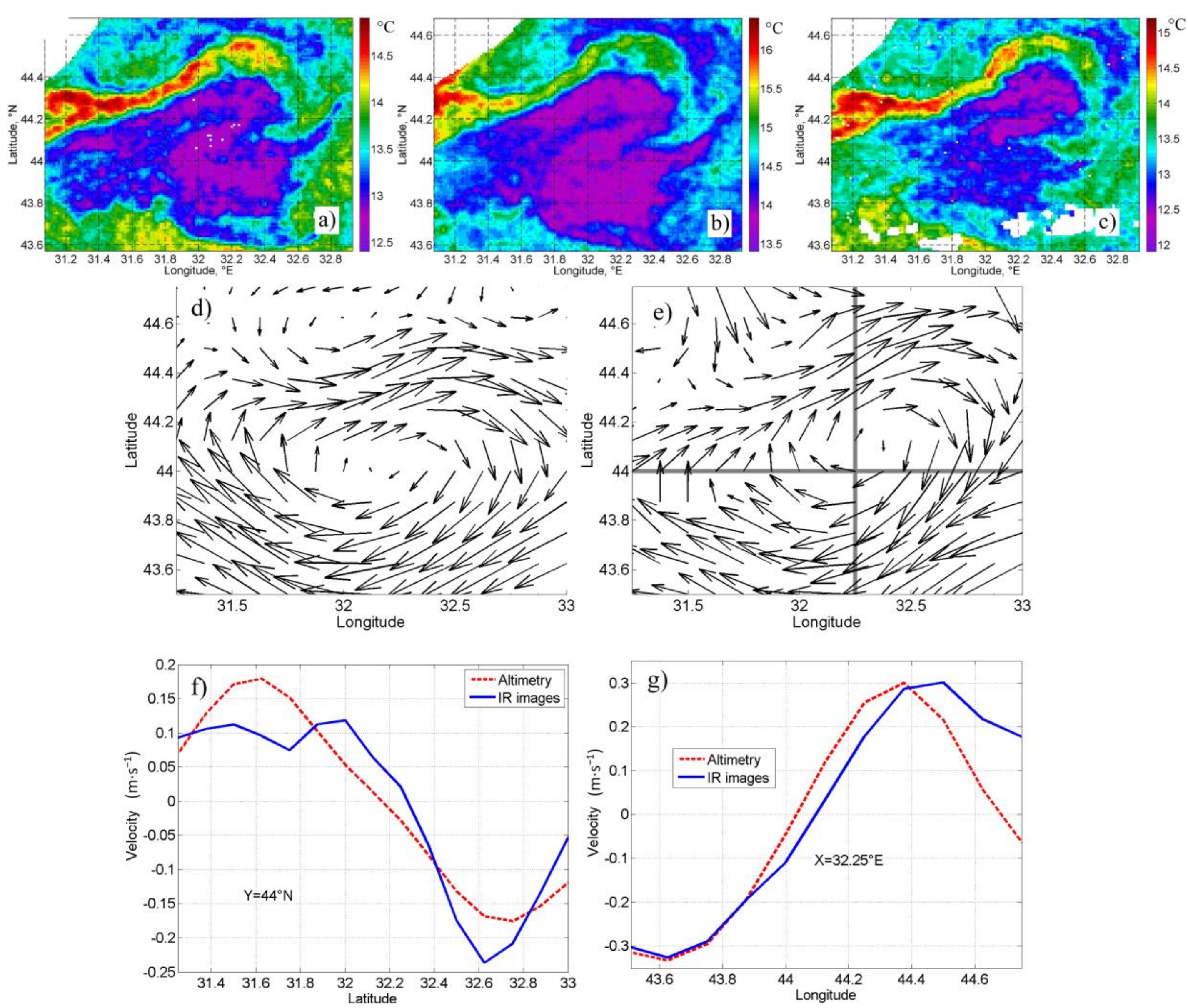
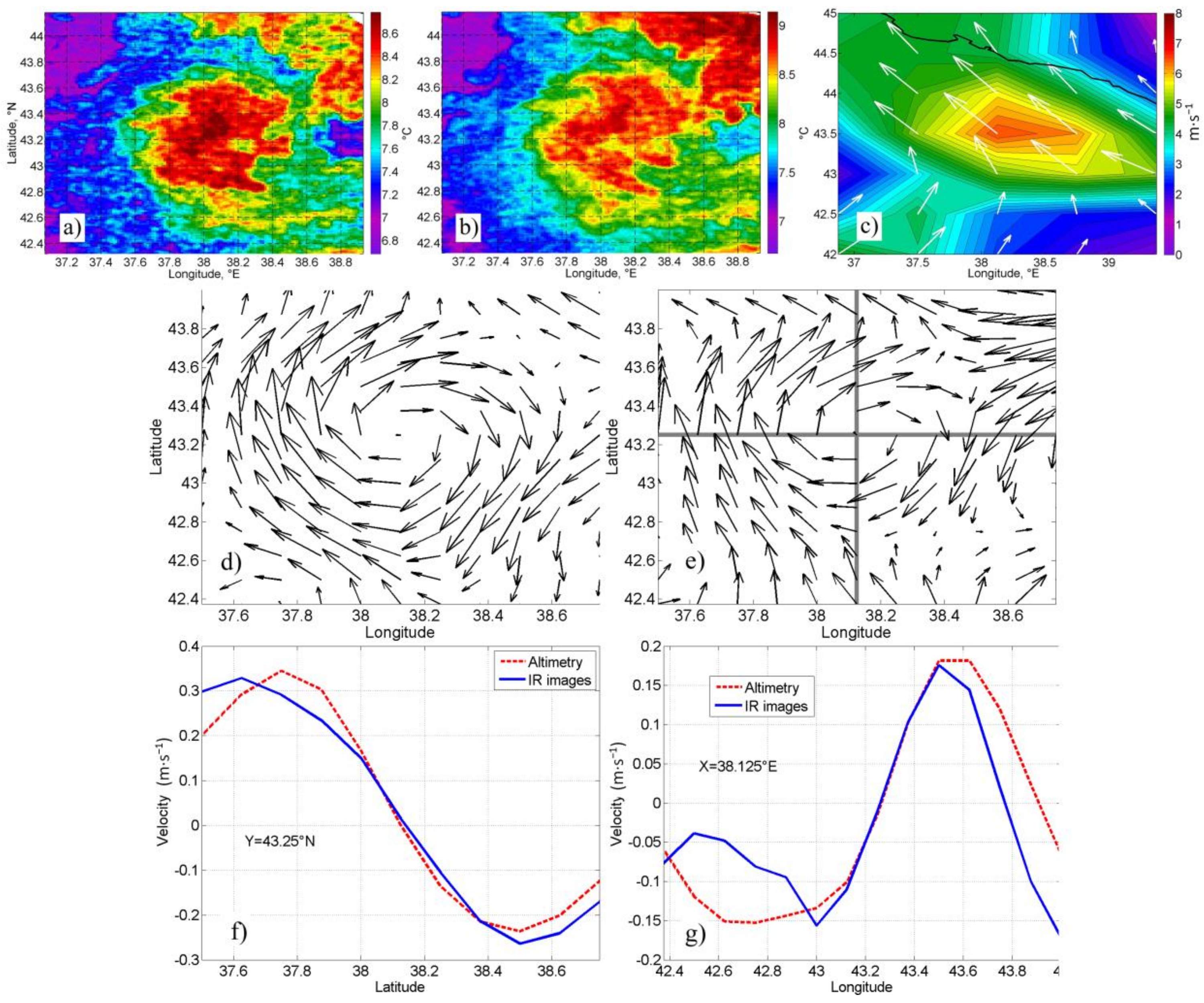
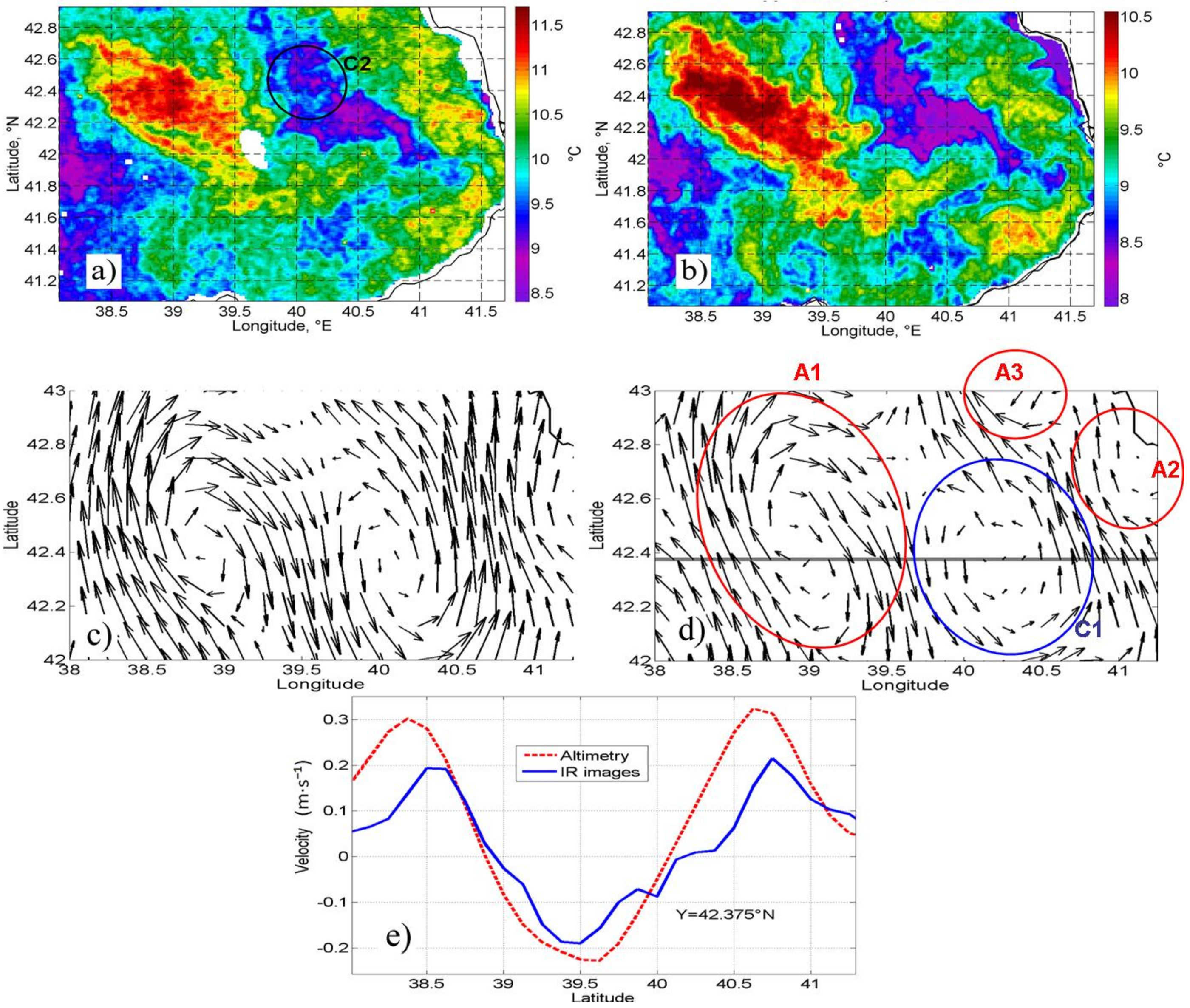
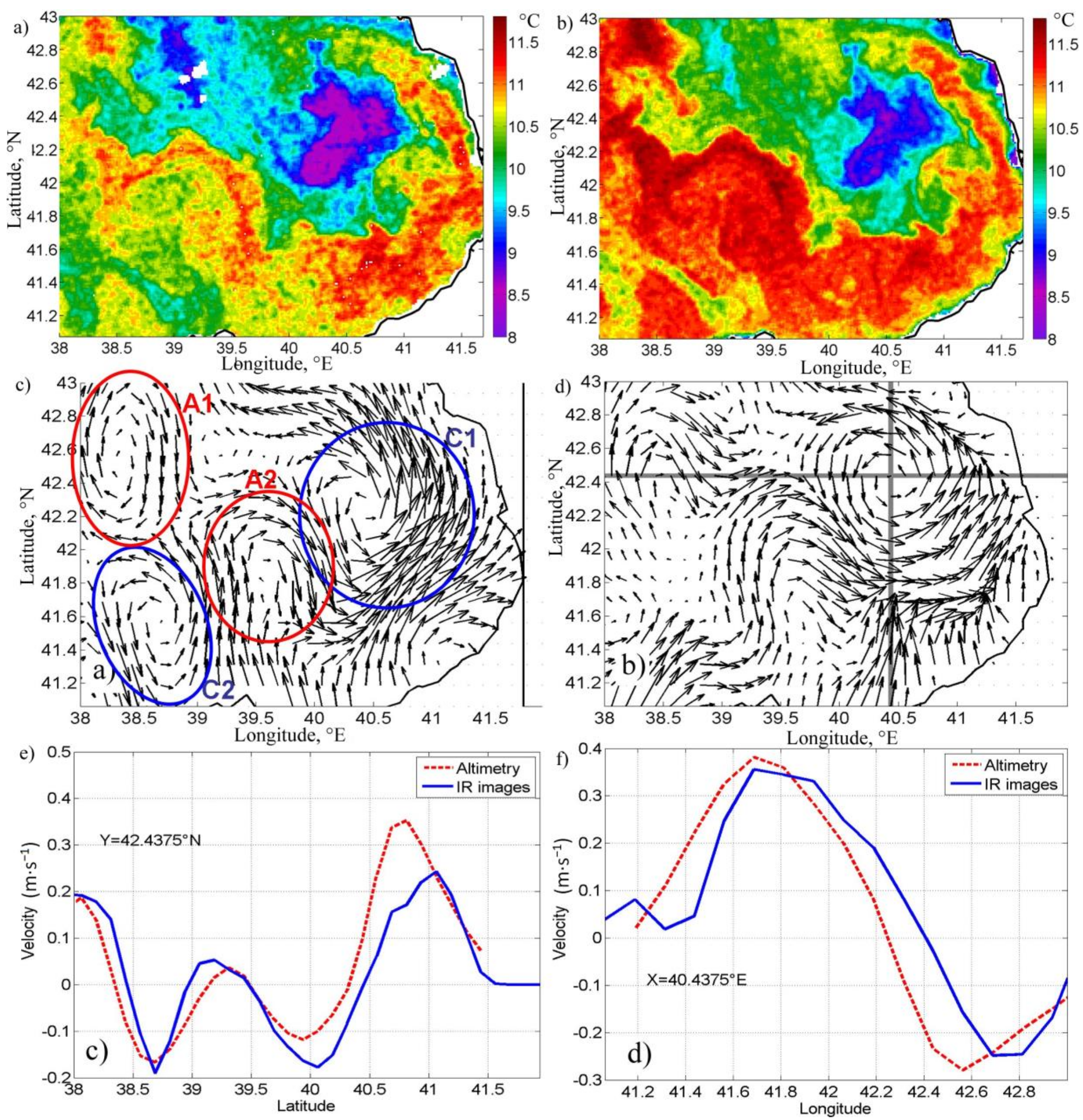
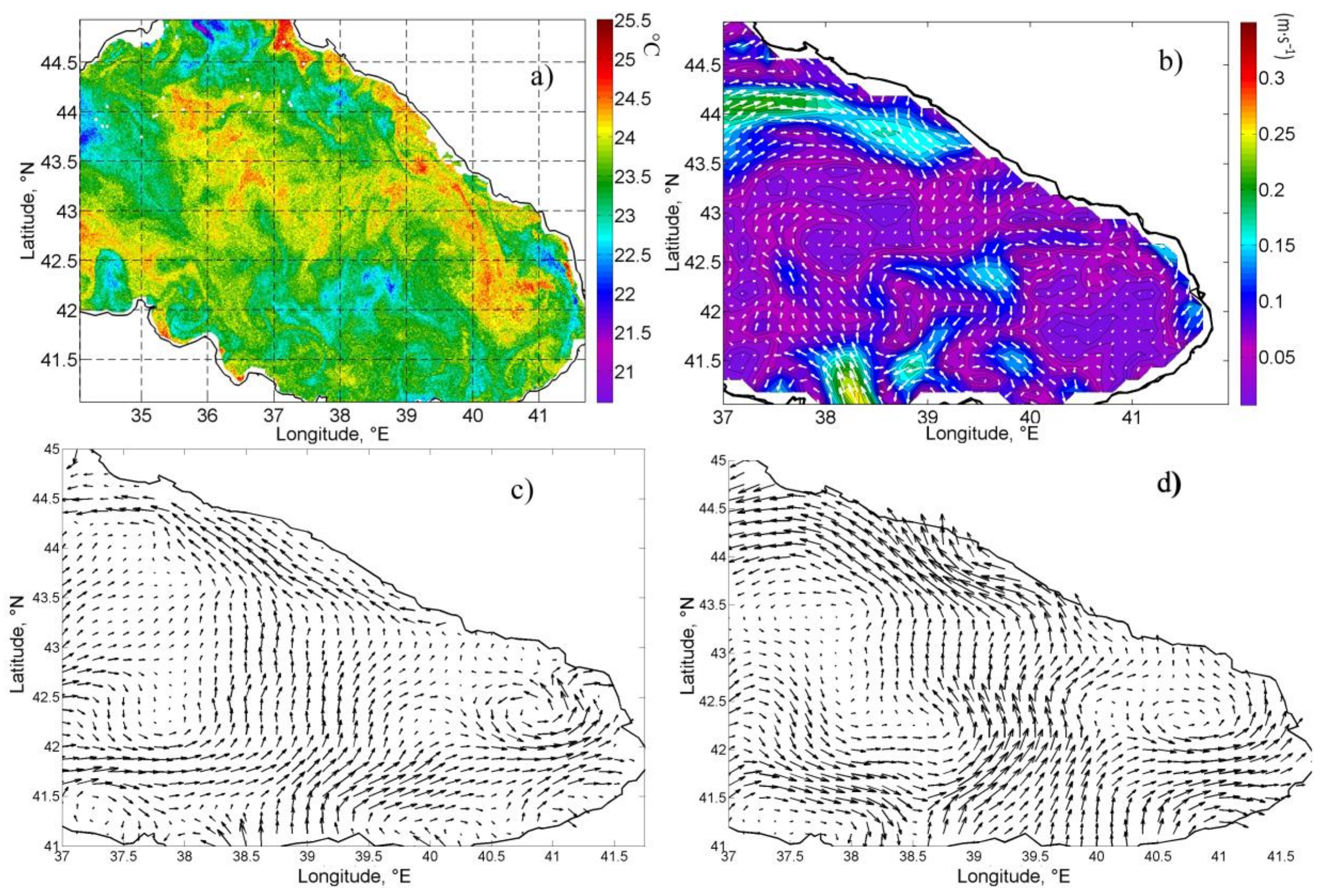


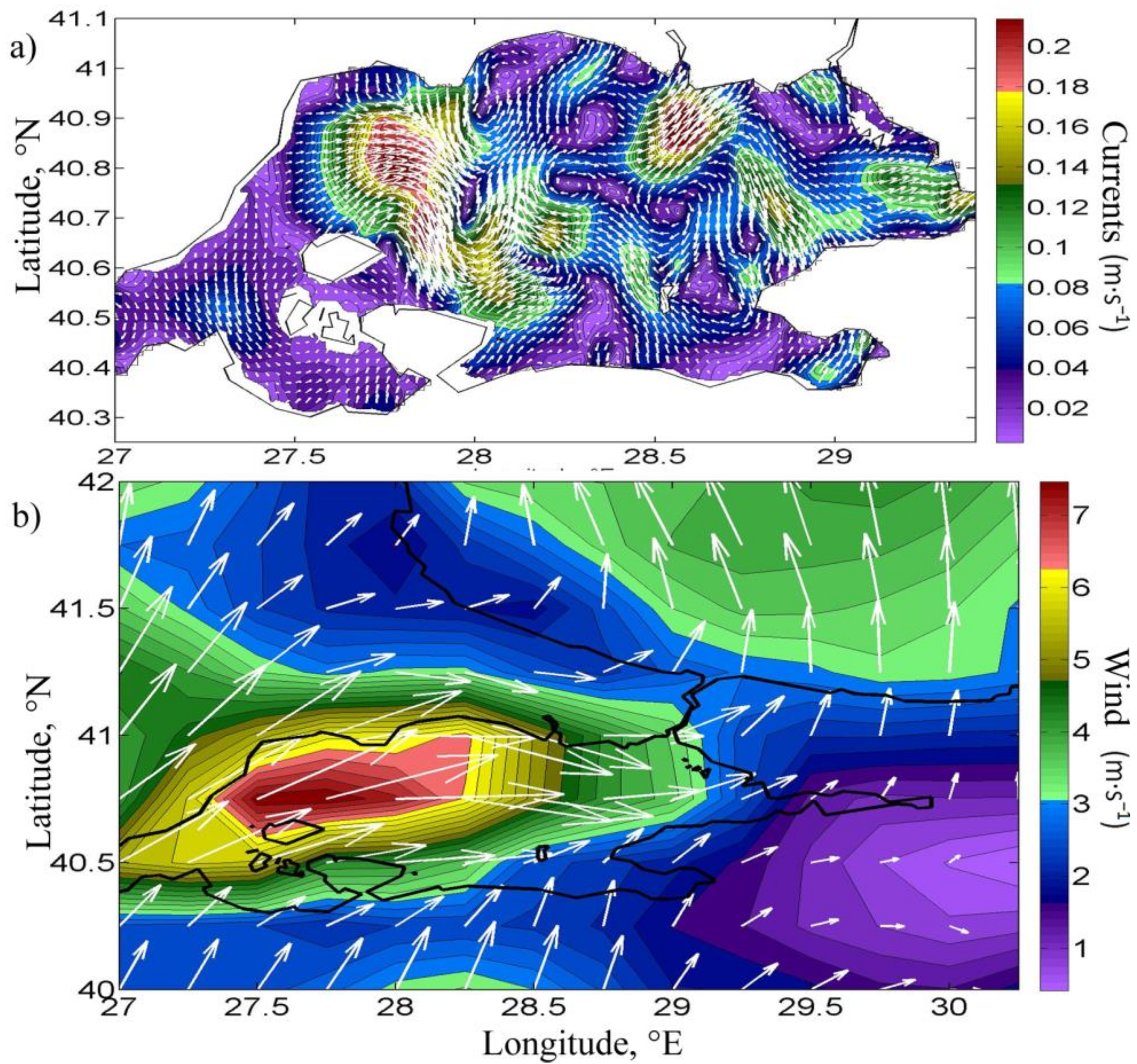
© 2018 by the authors. Licensee MDPI, Basel, Switzerland. This article is an open access article distributed under the terms and conditions of the Creative Commons Attribution (CC BY) license (http://creativecommons.org/licenses/by/4.0/).
Share and Cite
Kubryakov, A.; Plotnikov, E.; Stanichny, S. Reconstructing Large- and Mesoscale Dynamics in the Black Sea Region from Satellite Imagery and Altimetry Data—A Comparison of Two Methods. Remote Sens. 2018, 10, 239. https://doi.org/10.3390/rs10020239
Kubryakov A, Plotnikov E, Stanichny S. Reconstructing Large- and Mesoscale Dynamics in the Black Sea Region from Satellite Imagery and Altimetry Data—A Comparison of Two Methods. Remote Sensing. 2018; 10(2):239. https://doi.org/10.3390/rs10020239
Chicago/Turabian StyleKubryakov, Arseny, Evgeny Plotnikov, and Sergey Stanichny. 2018. "Reconstructing Large- and Mesoscale Dynamics in the Black Sea Region from Satellite Imagery and Altimetry Data—A Comparison of Two Methods" Remote Sensing 10, no. 2: 239. https://doi.org/10.3390/rs10020239
APA StyleKubryakov, A., Plotnikov, E., & Stanichny, S. (2018). Reconstructing Large- and Mesoscale Dynamics in the Black Sea Region from Satellite Imagery and Altimetry Data—A Comparison of Two Methods. Remote Sensing, 10(2), 239. https://doi.org/10.3390/rs10020239



